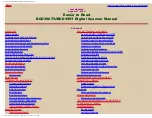
21
When the scanner receives a transmission on a channel set to the Motorola mode, it first
decodes the talkgroup ID data included with the transmission. In the Open Mode, the
scanner stops on the transmission and displays the talkgroup ID on the bottom line of the
display. In the Closed Mode, the scanner only stops on the transmission if the talkgroup
ID matches a talkgroup ID that you have stored in the bank's talkgroup ID list and have
not locked out.
Trunking systems covered by the Motorola mode come in four categories: Type I, Type II,
Type I/II Hybrid and APCO-25. Each category displays and uses talkgroup IDs in slightly
different ways.
Motorola Type I IDs are in the form FFF-SS, where;
FFF=Fleet ID
SS=Subfleet ID
Type I systems are usually organized with different user groups assigned to different
fleets.
Note
•
For example, a valid fleet-subfleet ID identifying all detectives within a police
department might be 000-12, where 000 identifies all police users and 12 identifies
the Detective division.
To properly map the raw Type I data to the correct fleet-subfleet format, you must
program the correct fleet map into the scanner. Fleet map information is widely available
on the Internet for most Type I systems in use.
Type II and APCO-25 system talkgroups are identified by a 5-digit number. Valid Type II
talkgroup IDs are divisible by 16, while APCO-25 talkgroups are not. Use care to ensure
that you enter the correct Type II IDs into your scanner. Type I/II hybrid systems use both
fleet-subfleet and 5-digit formats for talkgroup IDs.
Note
















































